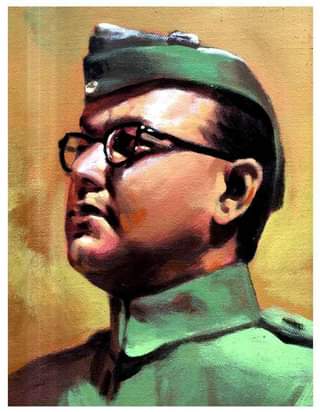On 23 January, the 125th birth anniversary of Netaji Subhash Bose, was celebrated as Parakram Divas. It was marked by an epochal event, whose national significance has not yet been fully grasped. The prime minister lighted a hologram of the 28-foot tall black granite statue of Netaji that will shortly come up under the very canopy where once the statue of King George V stood (till 1968). The pivotal location of the Netaji statue in the Central vista – behind the India Gate and facing the National War Memorial, speaks volumes in itself. It serves to end the sad marginalization of Bose and his Indian National Army (INA) and finally mainstreams those who decided to fight and win our freedom – not beg for it. It marks a paradigm shift in our foundational narrative of the state.
Foundational Narrative
So what is India’s founding myth? It was imposed upon us by the departing British and enthusiastically endorsed by the Brown sahibs to whom power was transferred. The myth was that India won its Independence by a unique non-violent freedom struggle waged by fasts, dharnas and spinning the charkha. In sum, India begged for its freedom and a benign Raj gifted it to us.
Was the British Raj benign? Utsa Patnaik has calculated that, by 1938, the British had looted some 44 trillion dollars of wealth to finance its industrial revolution. This systematic loot severely Impoverished an India, which was once generating 25 per cent of the world’s GDP. The British deliberately caused six major famines in a country that once overflowed with milk and honey. Some 18-20 million Indians perished in these famines.
Bose and the revolutionaries were clear – India would have to fight for its freedom. Germany and Japan had struck major blows against Britain. World War II was a golden opportunity to seek their help and drive out the British. It was now or never. Gandhi kicked Bose out of the Congress for his advocacy of violence. Bose went to Germany and raised a 3,000 strong Indesche Legion to fight for India’s freedom. When Germany began to lose the war in the West – Bose undertook a perilous submarine voyage to reach Japan and take command of the Indian National Army. He raised it to a strength of 60,000. He formed a provisional Government-in-exile in Singapore and declared war against Great Britain. He made a declaration of Indian Independence and along with the 15th Japanese Army attacked India via Imphal and Kohima. The INA lost the battles of Imphal and Kohima but strangely won the War for India’s Independence. How?
In a foolish gesture of triumphalism, the British decided to hold very public trials of INA prisoners to defame them and terrorise the rest of the British Indian Army. For the first time the people of India got to know that there was an army of Indians fighting heroically for their Independence. It led to an explosion of outrage in the major cities and deep unrest within the British Indian Army. The mathematics was brutally simple. There were 2.5 million armed and battle-hardened Indian soldiers in India and just around 40,000 British soldiers. The court-martials led to widespread rioting. Police firing failed to subdue the inflamed crowds. The accused had to be let off scot free. Intelligence reports indicated widespread resentment amongst the Indian troops and support for the INA.
It would be highly instructive for us to study the Transfer of Power Archives. In December 1945, Fd Mshl Auchinlek, C-in-C India wrote an appreciation of the situation. He apprehended that minor revolts would occur by Feb- Mar 1946 and a major revolt could erupt by June that year. He asked for five British Divisions and major air support to virtually re-conquer India. He made contingency plans to evacuate British families and personnel in Kabul-style actions from Indian cities with airports and harbours. The Viceroy, Fd Mshl Wavell endorsed his views. London was initially skeptical but panicked completely when the revolt started in the Royal Indian Navy on 18 Feb 1946. Revolts also broke out in army units in Jabalpur. In sheer panic, Lord Pethik Lawerence (Secretary of State for India) rushed to Delhi to start negotiations for transfer of power and partition of India.
Reclaiming our History
So, we are very certain now as to why the British left in 1947 in such panic. The sad fact is that the departing British handed over power to the Gandhi-Nehru combine and not the INA. They forced Gandhi to anoint Nehru as the prime minister. Nehru appointed Lord Mountbatten as the first Governor General of India (Pakistan chose Jinnah). Mountbatten barred the re-entry of INA personnel into the Indian armed forces. Treated as traitors they were denied their pay and pension and left to starve. Earlier, he had destroyed the INA war memorial in Singapore. The banishment of the INA was complete. Bose had vanished into thin air.
To gain political legitimacy, Nehru thumped the peaceful narrative of freedom and embarked upon global missions of peace and Ahimsa. In the bargain, India’s national security suffered enduring losses and setbacks. We almost lost Kashmir and failed to consolidate our borders with China in this rush for peace evangelism at the cost of the state’s security. Realism was forced on us after the 1962 debacle, yet there were occasional relapses to the peaceful narrative. Hopefully, the Bose statue and the making of an INA War Memorial in Delhi will signal a return of realism and a reclaiming of our history.













